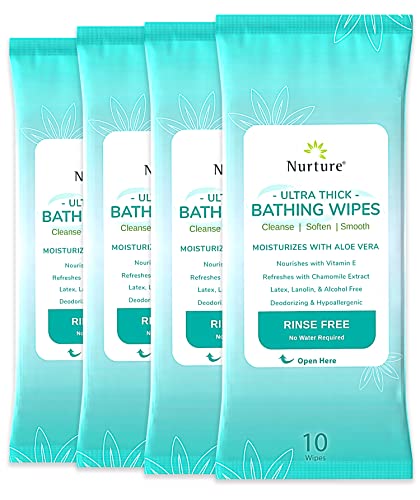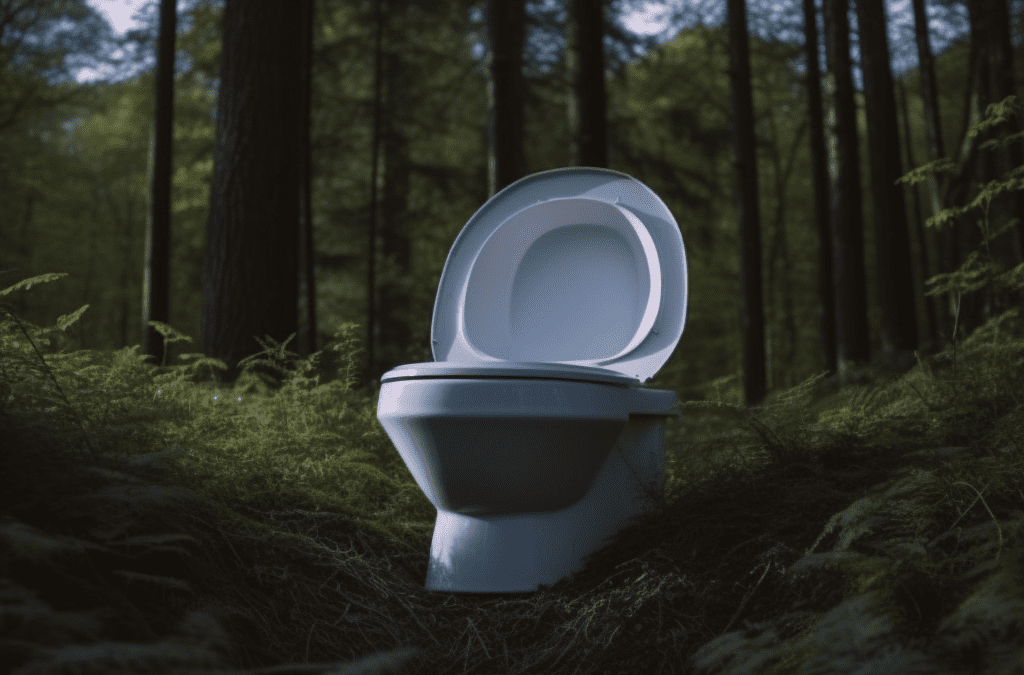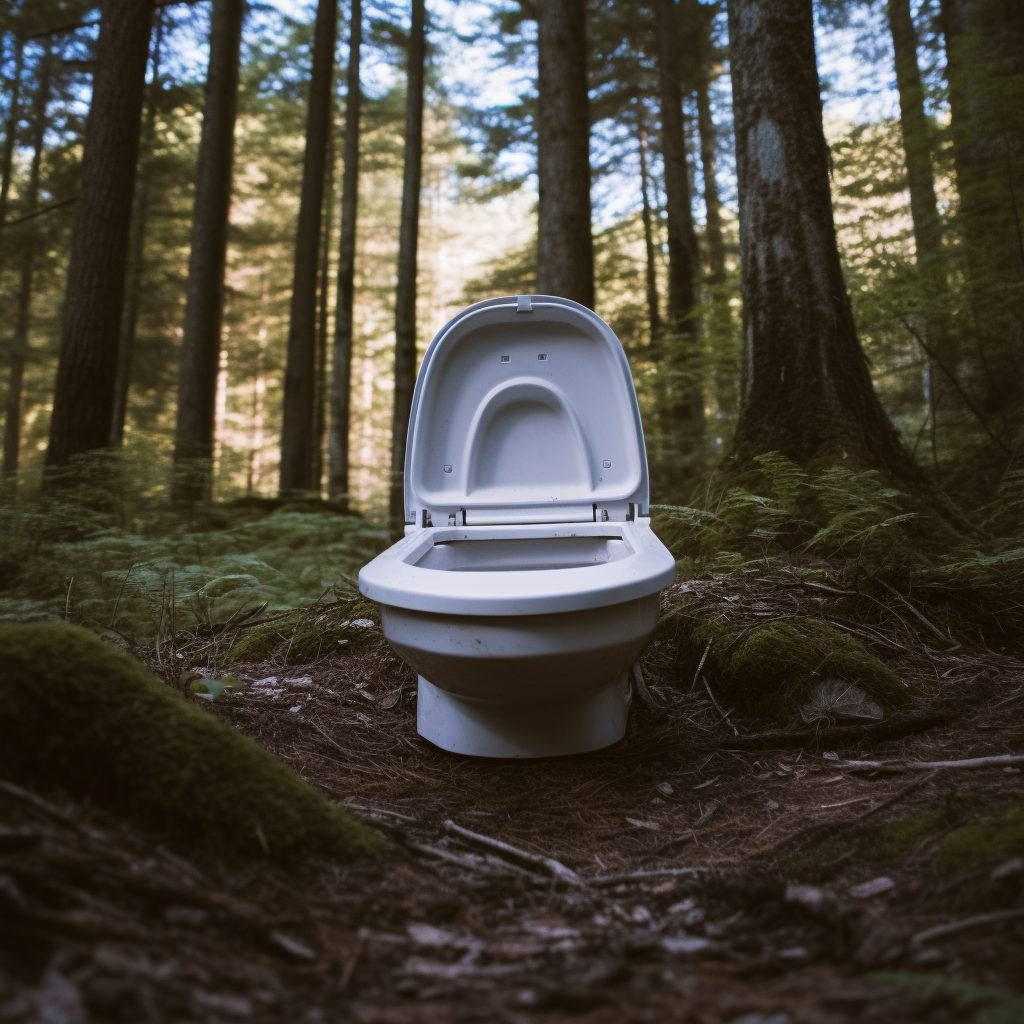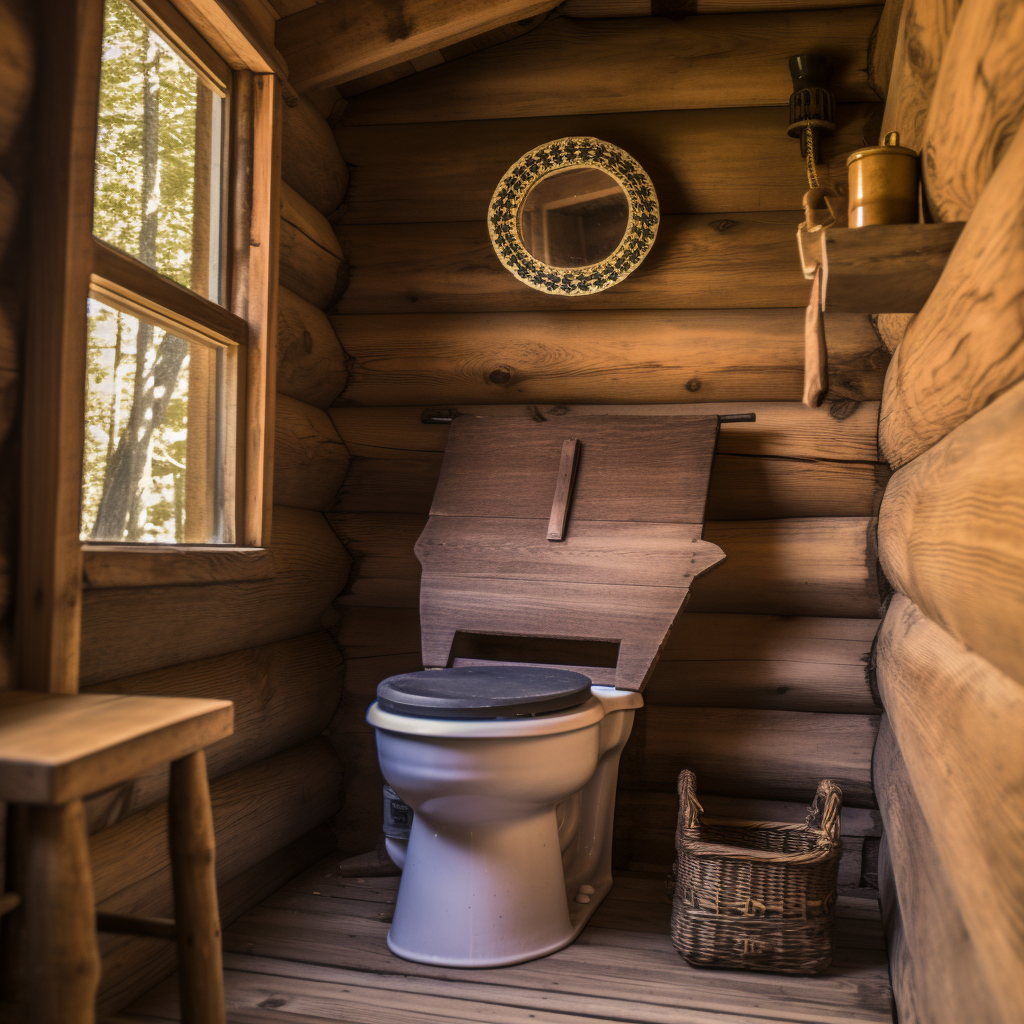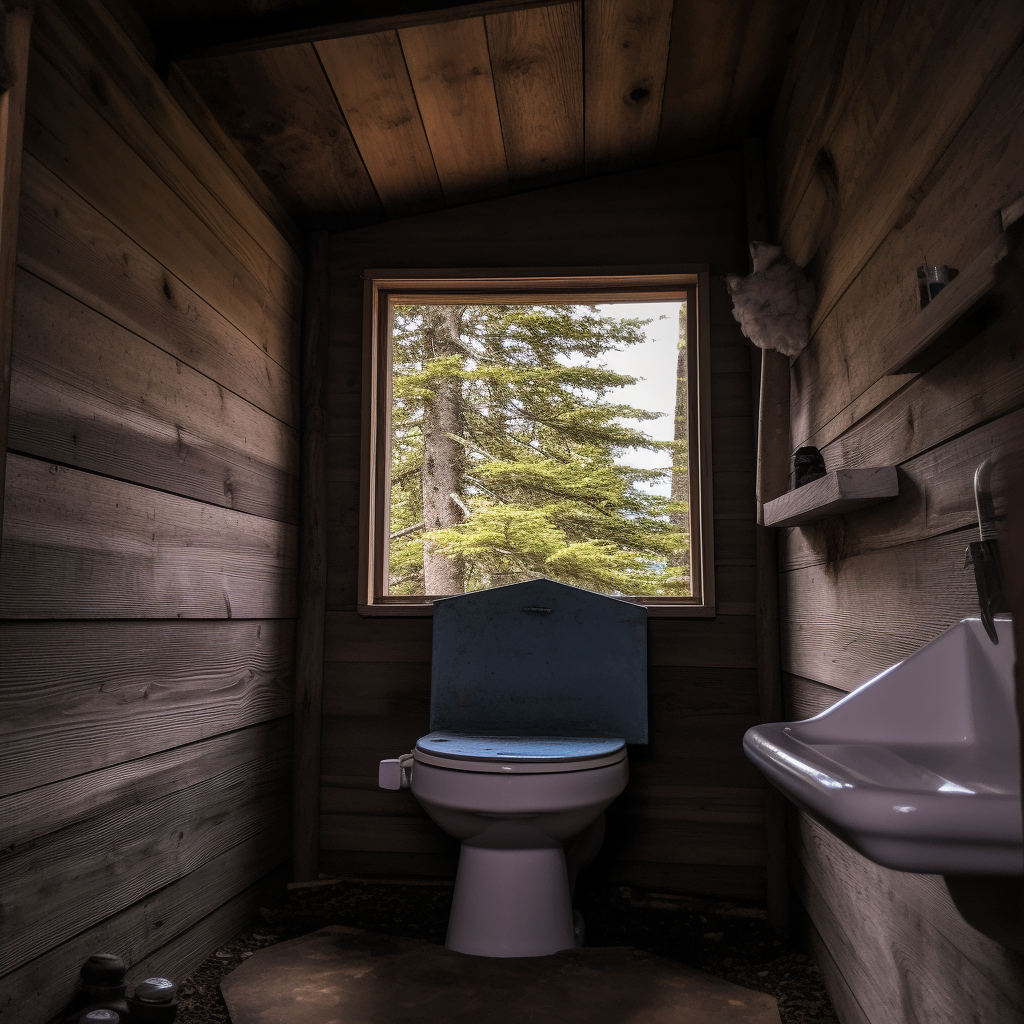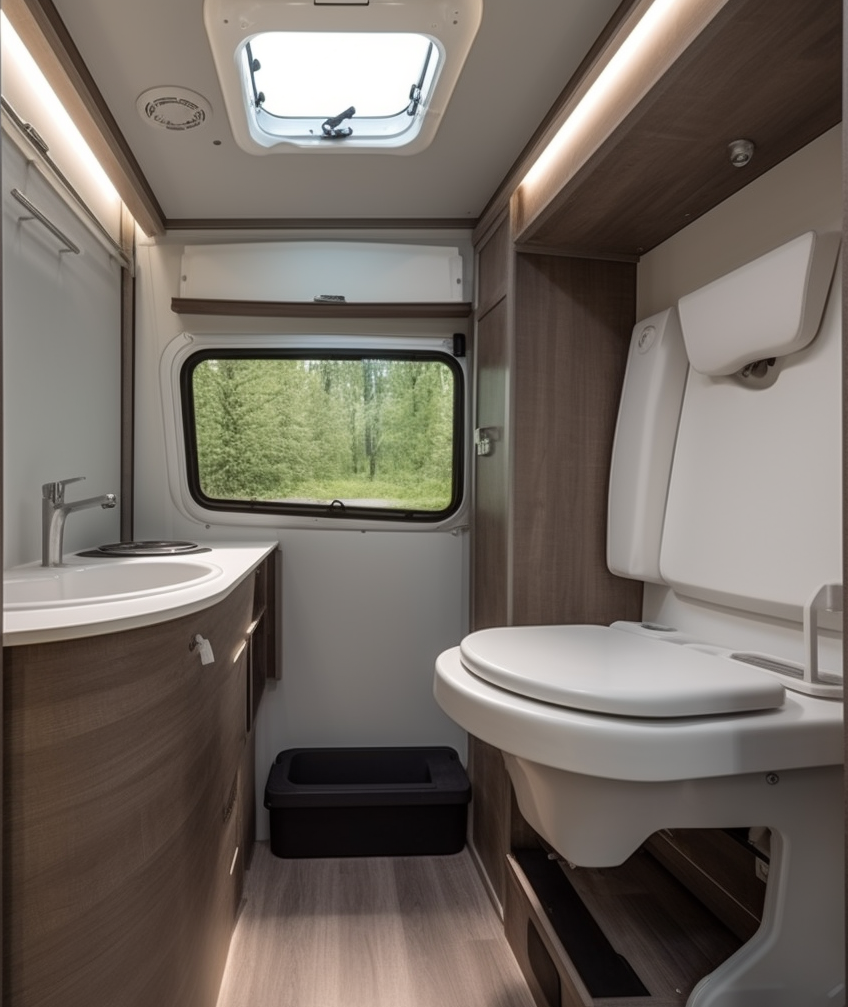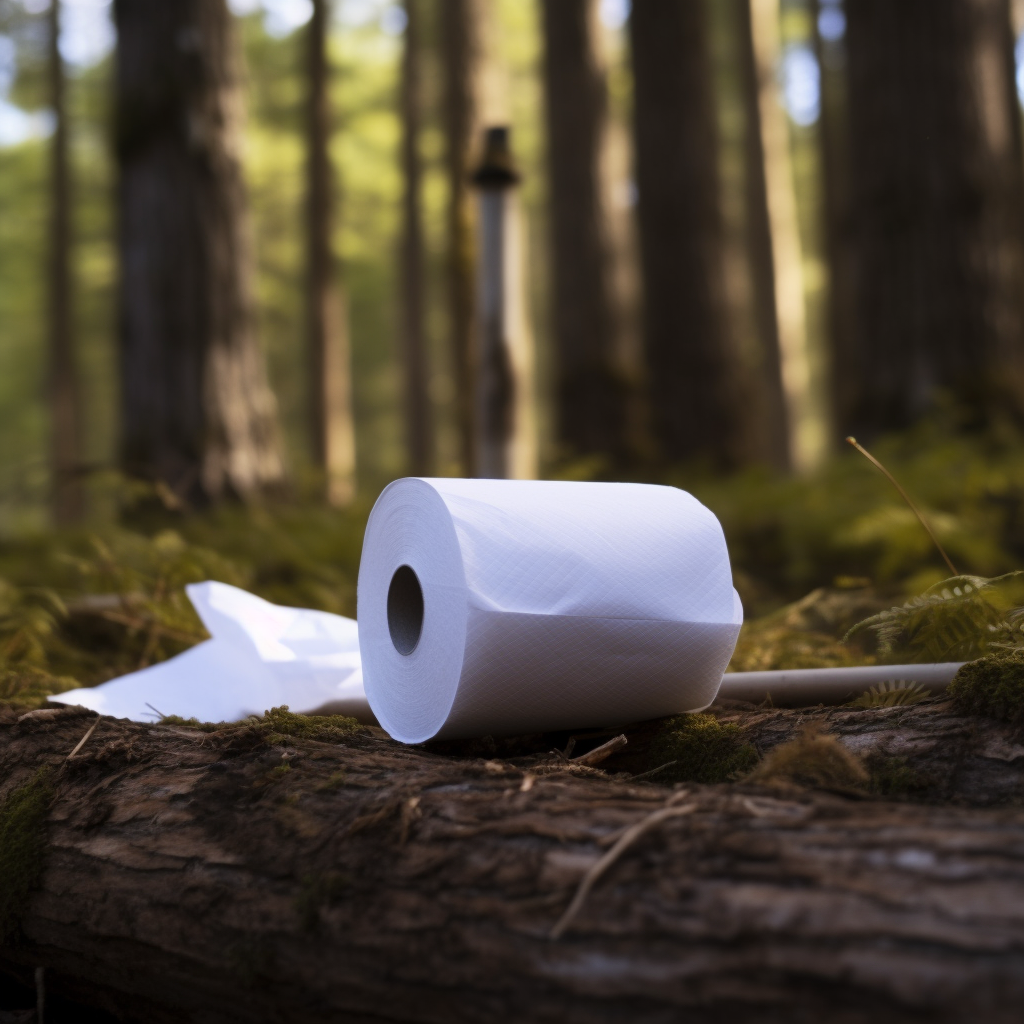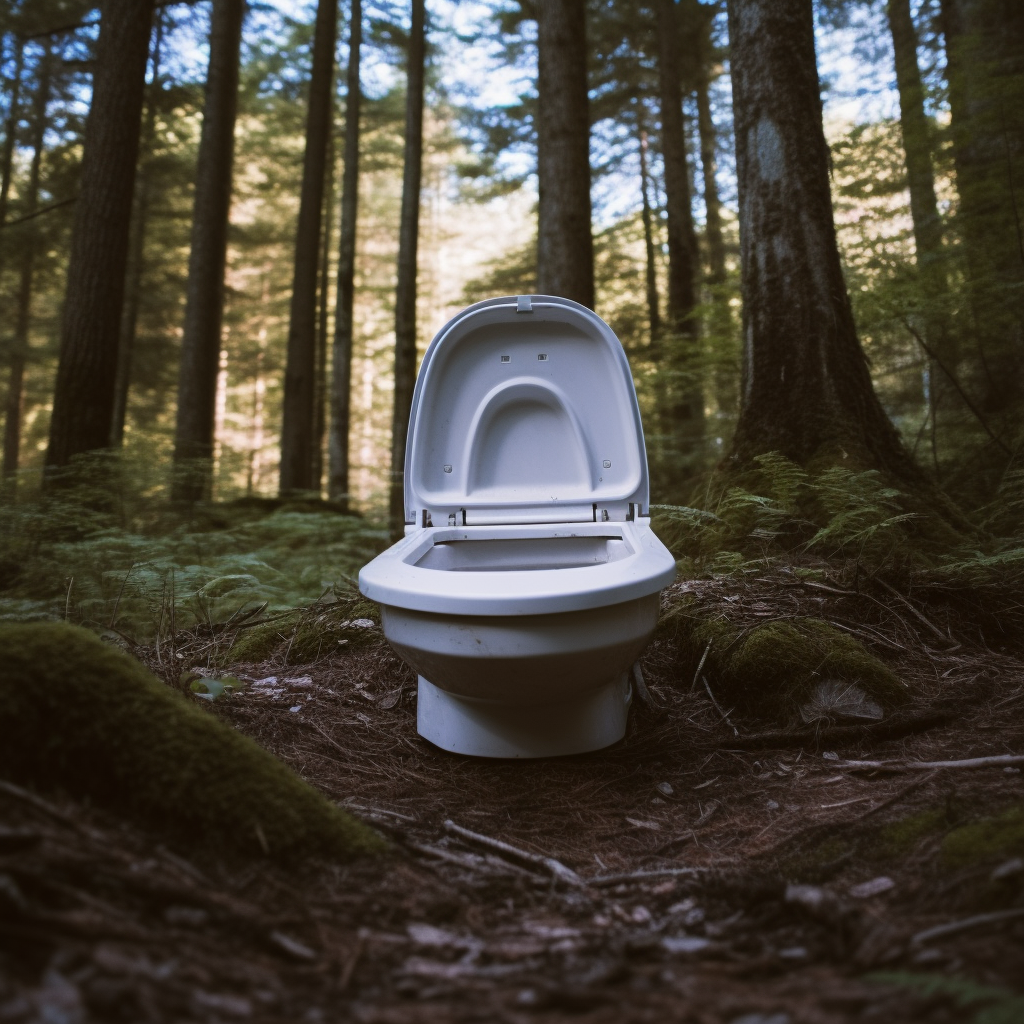
21 Off Grid Bathroom Ideas For Living When SHTF
Living off the grid, especially when SHTF, requires innovative thinking and creative solutions to everyday challenges.
One such challenge is maintaining hygiene, which is absolutely crucial for overall well-being and disease prevention.
If you’re thinking about setting up your off grid restroom, you’re in the right place!
So whether you’re planning a full-time shift to an off grid lifestyle, planning a camping trip or simply want to be prepared for any eventuality, you’re in the right place.
Read on to explore our list of different off grid bathroom ideas that will meet your needs and maintain your comfort when SHTF.
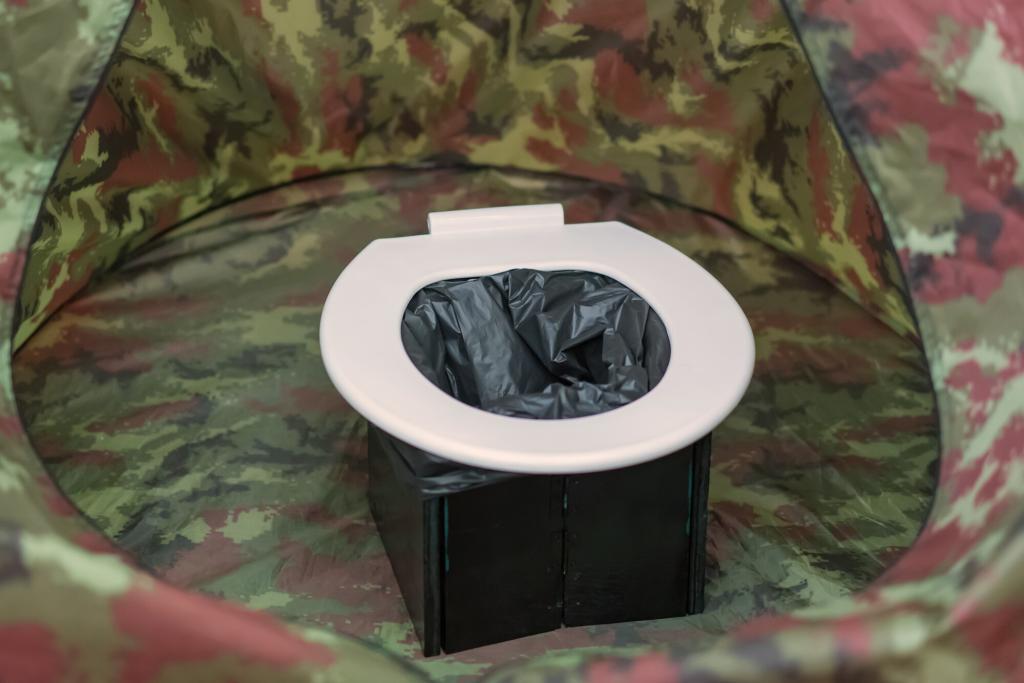
In This Guide
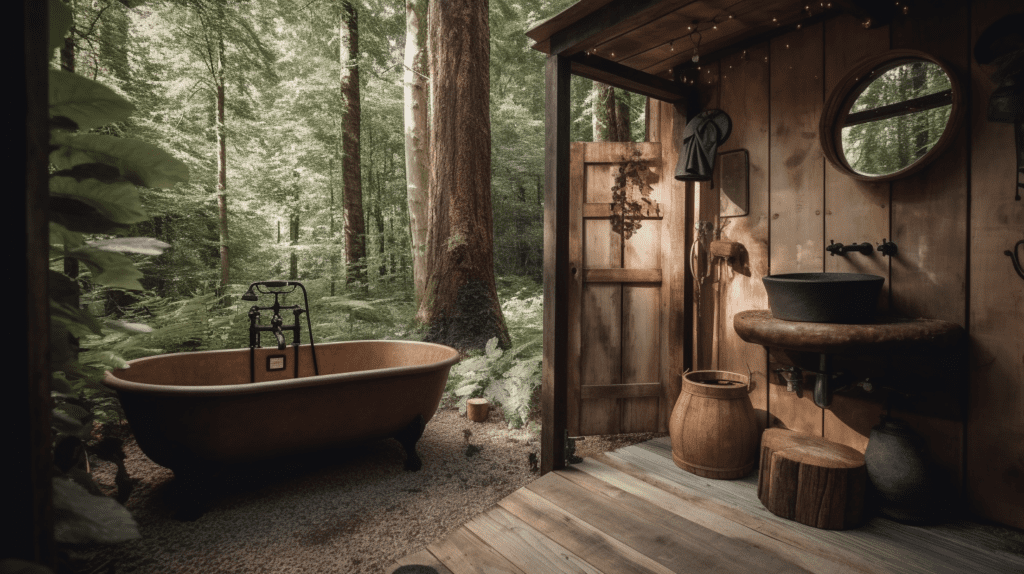
Off Grid Bathroom Ideas
Eco-Friendly Toilets
Living off grid doesn’t mean you have to sacrifice comfort or functionality in your bathroom.
There are several eco-friendly toilet options that can help you maintain hygiene while minimizing your environmental footprint. Here are some eco-friendly options:
1. Composting Toilets
Composting toilets are an excellent option for a tiny house bathroom, or if you’re simply looking for a waste management system that’s both environmentally friendly and sustainable.
These innovative toilets work by breaking down human waste into compost, which can then be used to fertilize soil.
Plus, they require no water, so you’ll save valuable resources and reduce your wastewater output.
However, they need regular emptying and maintenance, which involves handling fecal matter.
Pros:
- No water needed
- Creates compost that can be used as fertilizer
- Low-maintenance and odor-free when properly managed
- Reduces the need for sewage disposal
Cons:
- Requires regular emptying and maintenance
- More expensive upfront cost compared to traditional toilets
- May not be suitable for large families or heavy use
Here’s a video that shows you how to make one:
H/T @IMEEMADE
2. Humanure Toilets
The humanure bucket toilet, as the name suggests, is a type of bucket toilet system that focuses on turning human waste into compost or “humanure.”
Its process is straightforward. You start with a basic five-gallon bucket fitted with a toilet seat for comfort.
After each use, you cover the waste with a layer of carbon material, such as sawdust, peat moss, or straw, which helps control odors and kickstart the composting process.
Once the bucket is full, it’s emptied into a dedicated outdoor compost pile and left to decompose, eventually turning into nutrient-rich compost that can be safely used in gardening. The bucket is then cleaned and reused.
Pros:
- Excellent way to recycle waste
- Inexpensive to set up
- Easy to maintain
Cons:
- Requires a dedicated outdoor space
- Can take up to a year to produce usable compost
Here’s a guide on hope to use a humanure toilet:
H/T @twitchysquatch2262
If you want to know more about humanure composting, check out this handbook:
Written by an experienced humanure composter, this book delves into the history and environmental implications of recycling "human waste," addressing health risks and providing safe methods to transform humanure into garden soil.
3. Incinerating Toilets
Incinerating toilets are another off grid solution that offers convenience and minimal environmental impact.
These units use propane or electricity to burn waste, reducing it to a small amount of ash. They’re especially useful in areas where it’s not feasible to install a septic system.
Pros:
- No water or plumbing required
- Compact and easy to install
- Reduces waste to a small amount of ash
- No need for a septic system or sewage disposal
Cons:
- Requires a power source (propane or electricity)
- Requires using a liner every time you use it (bought separately)
- Ash needs to be disposed of periodically
The most popular incinerator toilet comes from the Cinderella company.
Here’s a review by @sonicsteelcontainerhomes8938:
4. Cassette Toilets
The cassette toilet is a popular choice due to its portability and compact design. You’ll likely find these types in camper vans.
This unique toilet system is divided into two main parts: the top section, which features the toilet seat, bowl, and flushing system, and the bottom part, which is essentially a removable cassette designed for waste storage.
You operate the toilet in a typical way, but when the waste tank fills up, it’s removed, transported, and manually emptied at an appropriate dump station.
Pros:
- Manageable and straightforward approach
- Compact size is ideal for use in small spaces
- Removable cassette is usually wheeled and comes with a handle, making it easy to transport and empty
- Uses a minimal amount of water for flushing
Cons:
- Requires frequent emptying
- You have to physically remove and empty the cassette
- Requires the regular addition of specific toilet chemicals
Check out this review of using a cassette toilet from the @Weretherussos:
Portable and DIY Toilet Ideas
Now if you’re planning an outdoor adventure or hosting an event where traditional bathroom facilities may not be available, portable and DIY toilets might just be the solution you need.
These self-contained and easy-to-assemble options come in a variety of styles and sizes, from simple bucket toilets to more complex composting models.
5. Portable Toilets
For those who want a temporary or mobile off grid toilet option, portable toilets are the way to go.
They’re typically lightweight, easy to use, and can be transported as needed.
Many models feature chemical additives to control odors and help break down waste.
Pros:
- Convenient and easily transportable
- Affordable upfront cost
- Suitable for temporary or remote locations
- Requires minimal maintenance
Cons:
- Requires regular emptying and cleaning
- Chemical additives may not be environmentally friendly
- Limited capacity compared to other toilet options
Check out these different types of portable toilets:
This portable toilet boasts an impressive 5.3-gallon tank that supports up to 120 flushes before it needs a refresh, all easily trackable with a useful waste level indicator.
It doesn’t leak or leave an unpleasant smell. Plus, made from top-notch, corrosion-resistant polyethylene, it’s durable and a breeze to keep clean.
This ultra-compact, portable folding toilet is sized for packing and easy to carry. It’s compatible with 6 to 8 gallon bags and is easy to clean and set up.
It also doubles as a stool, storage box, trash can, and more, which is pretty convenient.
6. Camping Toilets
A camping toilet is a portable, usually lightweight, sanitation device used when traditional bathroom facilities are unavailable or inconvenient.
It features a straightforward design that ranges from simple foldable stool frames with disposable waste bags to more sophisticated flushable systems.
For foldable or bucket-style toilets, you often just need to open it up and place a sanitary bag inside, ready for use.
More advanced models may require a bit of assembly and addition of a specific amount of water or chemicals for flushing and odor control.
Pros:
- Lightweight and easy to move
- Easy to use and maintain
- Offer a clean and sanitary solution compared to traditional outdoor methods
Cons:
- Regular cleaning and upkeep are required
- Advanced models like composting or chemical toilets can be more expensive
This portable toilet is perfectly paired with a pop-up tent, and includes 20 replacement bags. It’s also compact, foldable, and sturdy.
7. Separating Tank Toilets
A separating tank toilet, also known as a urine-diverting dry toilet (UDDT), is a unique off grid sanitation solution designed to separate solid and liquid waste at the source.
It’s a type of composting toilet that has two separate compartments for urine and feces to facilitate easier waste management and prevent unpleasant odors.
The toilet features a special bowl design that diverts urine into a separate front tank while directing solid waste into the rear compartment.
Urine can be either collected for safe disposal or repurposed as a nitrogen-rich fertilizer.
Meanwhile, solid waste dries out and decomposes over time into a safe, odorless compost that can be used in non-edible plant cultivation.
Pros:
- Minimizes the production of foul smells usually associated with mixed human waste
- Separated waste is easier to manage
- Uses no water for flushing
- Recycles waste into useful resources
Cons:
- Regular emptying and cleaning of both tanks is necessary
- Initial cost of a separating tank toilet can be higher than that of traditional or basic composting toilets
Here’s a video on how to make one:
H/T @dennislittlefield
8. Bucket Toilets
A bucket toilet, also known as a honey bucket, is among the simplest forms of off grid bathroom ideas.
Essentially, it’s a versatile bucket that can hold up to five gallons, fitted with a toilet seat and lid for added comfort and ease.
To use a bucket toilet, one just needs to position oneself on the seat and go about their business as usual.
To manage waste, it’s typical to line the bucket with a compostable bag for easy disposal.
Post-use, it’s advisable to cover the waste with a layer of absorbent material like sawdust, peat moss, or even shredded newspaper. This method helps in reducing odors and accelerating the composting process.
The full bag can then be safely composted in a dedicated area, while the bucket is cleaned and prepared for the next use with a fresh compostable bag and a layer of bulking material.
Pros:
- Simple design makes it easy to use, clean, and maintain
- Lightweight and compact
- Inexpensive solution, making them accessible for most budgets
Cons:
- Bucket’s size limits its capacity, requiring frequent emptying and disposal of waste
- Bucket toilets can produce noticeable odors if not maintained properly
- Uncomfortable to use
Waterless Toilet Ideas
These waterless toilets are a great option for those who want to reduce their water usage or live in areas where water is scarce.
These innovative toilets use little to no water, instead relying on natural processes like composting or evaporation to break down waste.
9. Dry Toilets
Dry toilets, also known as composting or waterless toilets work by separating liquid and solid waste, often using a urine diverter.
The solid waste is then mixed with a carbon-rich material such as sawdust, peat moss, or coconut coir, which aids in the composting process and reduces odors.
The liquid waste is usually diverted into a separate container and can be diluted and safely used as a fertilizer.
The solid waste is left to compost, often in a separate compartment or container. Over time, the composted waste can also be used as a nutrient-rich soil amendment, completing the waste-to-resource cycle.
Pros:
- Use little to no water
- Don’t require plumbing or a septic system, which means they can be installed virtually anywhere
- Environmental-friendly solution
Cons:
- Regular maintenance is necessary for effective operation
- Can take several months to a year for human waste to safely compost, requiring a secondary composting area or storage system
The most popular Dry Toilet is the Laveo Dry Flush Toilet. Learn how it works by watching this video:
H/T @SmokeyHills
10. Septic Systems
A septic system is a decentralized wastewater treatment structure often used in rural or off grid settings.
It’s essentially a self-contained underground waste disposal system that functions without the need for any connections to the main sewer lines.
In an off grid bathroom scenario, the septic system typically consists of two main parts: a septic tank and a drain field. The waste from the bathroom is routed into the septic tank, where solids settle at the bottom, forming sludge.
At the same time, oil and grease float to the top, creating a layer of scum. Bacteria in the septic tank then work to break down these solids.
The wastewater, now with fewer solids, flows from the tank to the drain field. Here, it is further treated as it percolates down through the soil, which acts as a natural filter.
Pros:
- Entirely self-contained
- With proper care and maintenance, a septic system can last for many years
- Eco-friendly way of treating wastewater naturally
Cons:
- Quite expensive; with costs depending on the size and complexity of the system
- Requires significant space for both the tank and the drain field
11. Outhouses/ Latrines
An outhouse, also known as a latrine, is one of the simplest off grid bathroom ideas, harking back to a simpler time.
Fundamentally, it’s a small structure covering a hole or pit dug into the ground, used for the disposal of human waste.
Using an outhouse is quite straightforward. The user sits or squats over the hole and does their business. Some modern outhouses may include a wooden or plastic seat for added comfort.
After use, it’s common practice to sprinkle a layer of soil, sawdust, or lime to cover the waste, helping to reduce odors and flies.
Outhouses can be designed with varying levels of complexity, from a rudimentary shelter over a pit to a more comfortable structure with improved ventilation, a door for privacy, and even decorative elements.
Pros:
- Simple to build and use, requiring minimal materials and technical expertise
- Functions without water
- Quite affordable, especially when compared to other off grid bathroom ideas
Cons:
- Require regular maintenance as the pit will eventually fill up and need to be emptied or a new one dug
- Usually built a fair distance away from the main dwelling, which can be inconvenient, particularly in bad weather or at night.
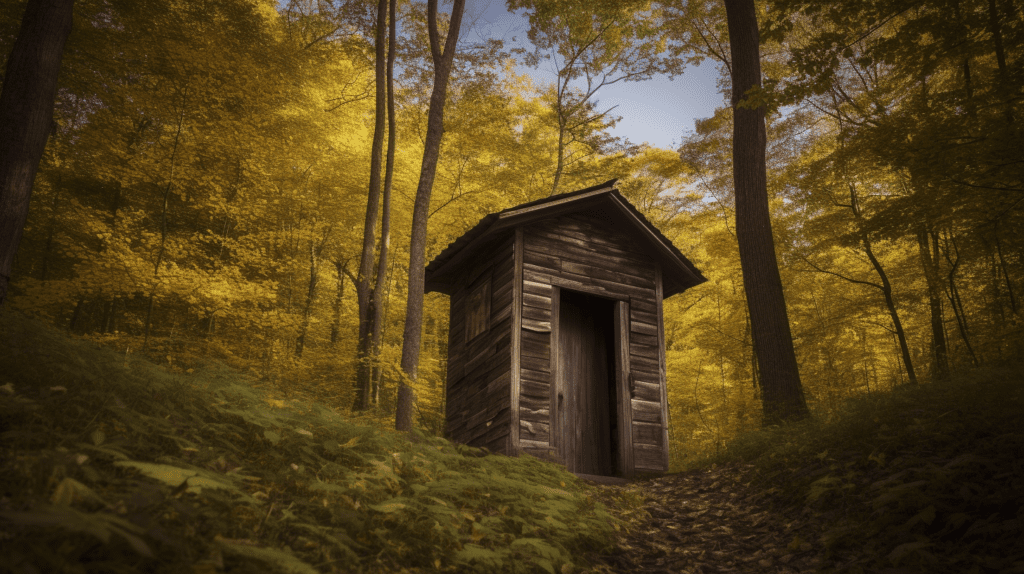
Portable Shower Ideas
12. Bucket Showers
The bucket shower, true to its name, is a rudimentary form of an off grid shower.
The principle is simple; you fill a bucket with water, which is equipped with a shower head or a spout at its base. The bucket is then lifted overhead, allowing gravity to force the water out.
Pros:
- Very budget-friendly and requires minimal setup
- It does not need electricity or sophisticated plumbing systems
- Highly portable and can be set up practically anywhere
- Easy to repair and maintain due to its simplicity
Cons:
- Limited water capacity can mean a short shower time
- Continually refilling and lifting the bucket can be physically demanding

13. Gravity-Fed Solar Showers
A gravity-fed solar shower typically incorporates a bag or container filled with water and left in the sun for warming.
Once adequately heated, the bag is elevated, and a small shower head releases the water. This option is ideal for those who want to enjoy hot showers, especially if you’re living in a cold area.
Pros:
- Utilizes solar power for water heating
- Gives the luxury of a warm shower without needing an external heat source
- No need for electricity or complex installation
- Portable and ideal for camping or outdoor activities
Cons:
- The water’s temperature and quantity rely on the sunlight and the size of the bag
- Requires time for the water to heat up, limiting spontaneity
If you’re planning to add a solar shower, here’s a great example:
This bag uses the sun's power to heat water to a toasty 113°F (45°C) within three hours. It's a green and safe solution for outdoor showers.
And no worries about running out of water too soon — this bag can hold up to 5 gallons for a refreshing shower. It also comes equipped with a hose, an easy-to-use shower head with adjustable water flow, and a water tap.
14. Pressurized Off Grid Showers
Pressurized off grid showers are simple systems where a water container is pressurized, often using a foot or hand pump, driving the water out through a shower head.
Some variants can also heat the water through a heat exchanger or solar energy.
Pros:
- Creates a steady water flow, similar to standard showers
- Can provide heated water depending on the model
- Allows for adjustment of water pressure
- Can be set up in various locations
Cons:
- Tends to be more costly and complicated to install compared to more straightforward options
- Regular manual effort is needed to create pressure
This durable, leak-proof, and BPA-free outdoor shower is crafted from industrial-grade high-density polyethylene for long-lasting performance. holds about 1.5 gallons or 5.5 liters.
Plus, it offers five different nozzle settings ranging from Jet to Super Pressure Jet, so you can customize your cleaning.
15. Portable Camping Showers
Portable camping showers are compact and lightweight shower systems explicitly designed for portability.
They usually include a water reservoir, a heating component (often solar-powered), and a low-flow shower head.
Pros:
- Highly portable, making it ideal for various outdoor activities
- Easy to use with minimal setup
- Some models offer heated showers via solar energy
- Useful in situations with limited space or resources
Cons:
- Water volume tends to be limited, meaning shorter shower times
- May lack the pressure and heat intensity of conventional showers
Waterless Bathroom Ideas
With a few innovative waterless bathroom solutions, you can maintain a high level of personal care even without plumbing or running water.
Let’s explore three popular options.
16. Navy Showers
A Navy shower, popularized by sailors or military personnel living in confined spaces, can be your go-to solution for water conservation. They’re especially well-suited for tiny houses and off grid living because they use very little water.
Here’s how it works:
- Turn on the water and quickly get wet.
- Turn off the water and lather up with soap and shampoo.
- Turn on the water again to rinse off.
This simple process reduces water usage to just a few gallons per shower while still getting clean. The only downside? They might feel less luxurious than a regular shower, but that’s a small trade-off for sustainability.
Pros:
- Reduces water and energy consumption
- Effective solution for areas where water is scarce
Cons:
- Feels rushed
- Can be chilly
17. Wet Wipes
Wet wipes are an excellent alternative for cleaning your body without relying on running water.
Originally designed for baby care, they’ve become increasingly popular in a variety of contexts, including camping and off grid living.
They’re a handy tool to have in your off grid bathroom arsenal. Just remember to dispose of them responsibly.
While wet wipes are a handy solution for maintaining hygiene in off grid situations or emergencies, nothing beats a good old-fashioned shower.
So it’s important to also incorporate regular bathing into your routine whenever possible.
Pros:
- Quick and convenient
- Require no water or rinsing
- Easily portable
Cons:
- Single-use, generating waste
- Less thorough than showering
This is a pocket-friendly shower alternative that’s gentle and effective for cleansing the skin.
These are four times thicker than standard wipes and provide an unrivaled waterless bathing experience without needing a rinse.
Plus, they're ideal for on-the-go freshness, so you can enjoy the comfort of a full-body cleanse anywhere, anytime.
18. No-Rinse Cleansers
No-rinse body cleansers have gained popularity among campers and those in the healthcare industry for their water-saving qualities.
The formulation is designed to lift and remove dirt, sweat, oils, and odor.
These cleansers simply need to be applied to your skin and wiped off with a towel or cloth without needing a wash or rinse afterward.
However, they might be less effective for heavy dirt or sweat removal.
Pros:
- Significantly reduce the amount of water needed for personal hygiene
- Easy to use, quick, and convenient
- Compact packaging can save space in your bathroom
Cons:
- They don’t entirely replace the feeling of a good, thorough wash with water
- Some may experience irritation.
This no-rinse cleanser is packed with aloe vera and natural nourishing ingredients. It’s also vegan-friendly, hypoallergenic, pH balanced, and free from parabens and sulfates.
It also moisturizes your skin with hydrating aloe vera and essential vitamins.
It’s a refreshing shower in a bottle, ready to keep you feeling fresh wherever you go.
Energy Saving Shower Ideas
These energy-saving showerheads are designed to use less water and energy, but they don’t compromise your shower experience.
You can still enjoy a satisfying shower with the same water pressure and comfort as traditional shower heads while also reducing your environmental impact.
19. Solar Water Heaters
Using solar water heaters is a great way to harness the sun’s energy and save on power consumption. This method involves using a free, renewable source of energy instead of relying on electricity or propane to heat your water.
There are several different types, but in essence, they involve a solar collector — usually a panel or evacuated tube design that absorbs solar radiation and transfers it to water.
This system stores heated water in an insulated tank for on-demand use, perfect for bathing in cold climates.
They can either be passive, relying on natural convection to move the hot water, or active, which uses pumps and controllers.
In an off grid scenario, a passive system is typically preferred as it doesn’t require electricity.
To get started, you can either purchase a ready-made solar water heating system or build your own.
Pros:
- Low operating costs
- Systems can be sized to meet individual needs
- Require little upkeep
Cons:
- Upfront cost of purchasing and installing a solar water heater can be high
- Effectiveness of solar water heaters is contingent on the availability of sunlight

Reuse and Recycle System Ideas
20. Greywater Systems
Greywater systems allow for the recycling of water from showers, sinks, and washing machines. This system separates greywater (lightly used water) from blackwater (heavily polluted water, typically from toilets), allowing for different treatment and reuse strategies.
Greywater, with its relatively minor contamination, can be filtered and repurposed for non-potable uses such as flushing toilets, watering plants, or even showering again with additional purification.
For off grid bathroom ideas, incorporating a greywater system can mean the installation of pipes to direct the water from your fixtures to a treatment area.
Here, the water is filtered and treated before being used in gardens or toilets.
Pros:
- Saves resources by recycling water
- Helps reduce strain in septic systems
- Helps you save money in the long run
Cons:
- Can be expensive at first due to the potential need for plumbing modifications
- Need regular maintenance to ensure the water is being treated properly and that the system is working effectively
Check out this video that shows you how to make your greywater system:
H/T @SteepintheWoods
21. Rainwater Harvesting Systems
Rainwater harvesting is another eco-friendly solution for your off grid bathroom. It’s a simple idea: collect rainwater and use it for your daily needs, like flushing toilets and washing clothes.
To get started, you’ll need a storage tank and a proper gutter system to channel the water flow.
Pros:
- Reduces your dependence on the water grid
- Lowers your water bill
- Provides a backup in times of drought or water shortage
Cons:
- Rainfall patterns may vary, making it hard to predict the amount of water available
- You may need additional filtration or treatment for certain uses
Here’s a video showing you how to create a rainwater harvesting system you can use for your off grid bathroom:
H/T @homesteadonomics
What Is An Off Grid Bathroom?
An off grid bathroom is a self-contained, self-sustaining restroom facility that functions without relying on traditional public utilities like water supply, sewage systems, or electricity.
The core philosophy behind an off grid bathroom is achieving sustainability and self-reliance, often in preparation for situations where conventional services are unavailable or when one chooses to live removed from societal dependencies.
Off grid bathrooms can vary greatly in their design, complexity, and luxury level, depending largely on the available resources, the user’s skill, and their specific requirements.
Elements Of An Off Grid Bathroom
There are a few elements that are common across most off grid bathrooms, which are the following:
Water Supply: This may be sourced from rainwater harvesting, wells, nearby streams, or even manual hauling. The water is often stored in containers or tanks and is used sparingly to minimize wastage.
Toilet Facilities: Off grid bathrooms frequently feature composting toilets, which require no water and convert human waste into compost that can be used as fertilizer.
Other options might include incinerating toilets or basic pit latrines.
Lighting and Heating: These can be powered by renewable energy sources such as solar panels or wind turbines.
In some cases, wood-burning stoves might be used for heating.
Waste Management: Greywater (from sinks, showers, etc.) and blackwater (from toilets) are often dealt with on-site.
Greywater can be reused for tasks like watering plants, while blackwater is often composted or disposed of in a safe and environmentally friendly manner.
Bathing Facilities: These can range from simple bucket showers to full-fledged shower stalls, heated by solar power, propane, or wood-fired water heaters.
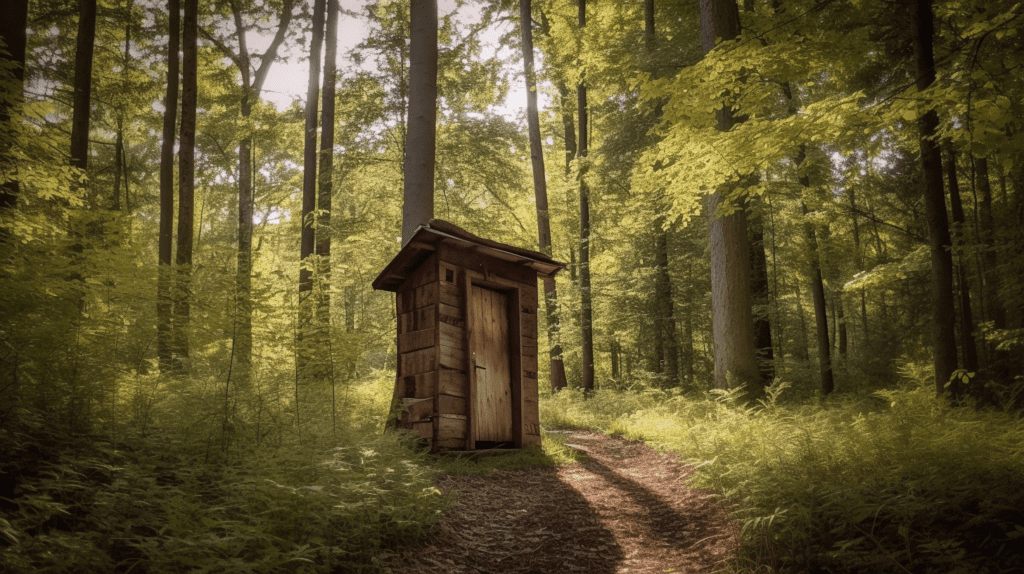
Why Make An Off Grid Bathroom?
Creating an off grid bathroom can offer numerous advantages, here are some reasons why you should have one:
Self-Sufficiency
This is one of the most attractive benefits of an off grid bathroom. It reduces reliance on external utilities, ensuring that your essential sanitary needs continue to be met even during power outages, natural disasters, or when living in remote areas.
Environmental Impact
Off grid bathrooms typically employ eco-friendly solutions like composting toilets and rainwater harvesting, reducing water usage and waste production.
This can significantly decrease your carbon footprint and contribute positively to the environment.
Cost Savings
While there might be some initial costs involved in setting up an off grid bathroom, over time, savings on water and electricity bills can be substantial.
Additionally, many off grid solutions are designed to be low-maintenance, which can further save on upkeep costs.
Versatility and Adaptability
Off grid bathrooms can be designed to fit various scenarios, from permanent residences to vacation cabins, RVs, or even emergency shelters.
They can be adapted to your particular needs, resources, and the environment you’re in.
Legal and Zoning Freedom
Some people choose off grid living, which includes off grid bathrooms, to escape restrictive building codes and regulations in certain areas.
However, it’s essential to note that you should always check and adhere to local regulations wherever you plan to establish your off grid setup.
Educational Value
Building and maintaining an off grid bathroom can be a rich learning experience, teaching valuable skills like plumbing, carpentry, and understanding water and waste management.
Preparedness
For those interested in emergency preparedness or a survivalist lifestyle, an off grid bathroom is an important component of being ready for any situation where traditional utilities might be disrupted.
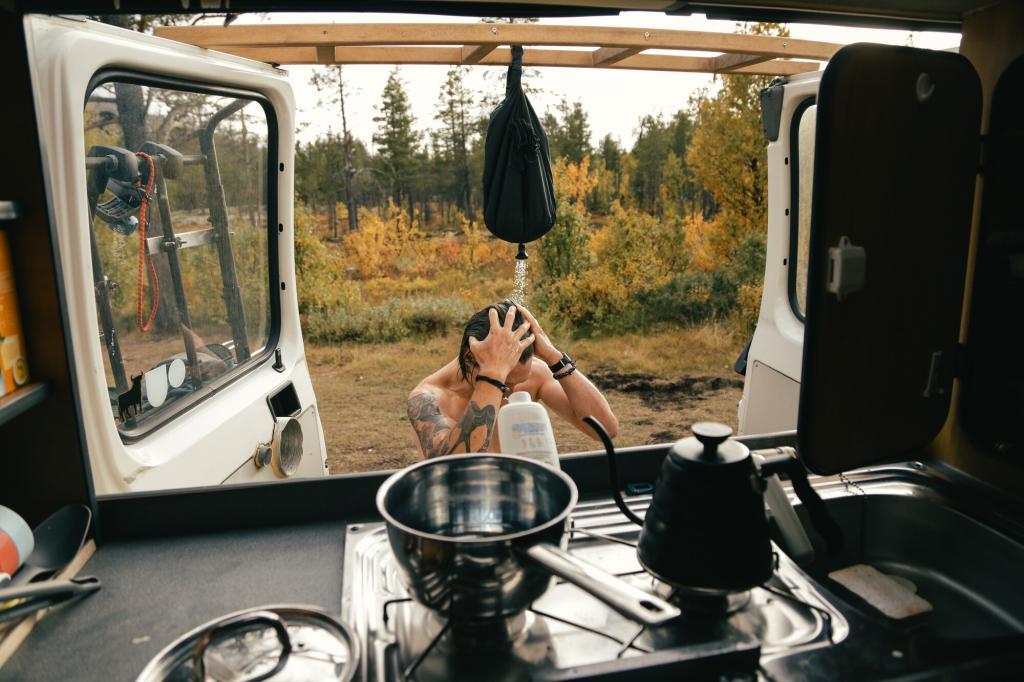
What To Consider When Designing An Off Grid Bathroom
With careful planning, you can create a functional and beautiful space that meets your needs and promotes sustainability. Here are some factors you need to consider:
Space Optimization
When designing an off grid bathroom, you’ll want to make the most of the available space. Think about creative ways to maximize storage, such as using built-in shelves or multipurpose furniture.
For example, a sink that doubles as a countertop or a mirror with hidden storage would be great additions.
Compact, wall-mounted fixtures also help free up more room, making your bathroom feel spacious and comfortable.
Ventilation and Drainage
Proper ventilation and drainage are essential components of an off grid bathroom. Without adequate airflow, moisture can build up, leading to issues like mold and mildew.
Strategically place windows or vents to promote natural airflow, or consider installing solar-powered exhaust fans if necessary.
For drainage, you could explore options such as septic systems or compostable off grid toilets. You want to ensure that waste is managed properly to avoid unpleasant odors and environmental issues.
Natural Materials
Using natural materials in an off grid bathroom creates an eco-friendly and harmonious space. Consider materials like wood, stone, or bamboo for flooring, walls, or countertops.
These materials not only look great, but they’re also durable and easy to maintain.
Additionally, incorporating natural elements can seamlessly blend your bathroom with the surrounding environment, creating a tranquil and cozy atmosphere.

What To Consider When Building An Off Grid Bathroom
Choosing the right off grid bathroom is a highly personal decision, as the best choice depends on your unique lifestyle, preferences, and needs.
Here are the things you need to consider before you plan to build your off grid bathroom:
Understanding Your Specific Needs
Whether you’re honing your skills in the wild or preparing for a self-sufficient lifestyle in an isolated retreat, your specific bathroom needs play a crucial role in your decision.
If your plan involves being mobile, traversing terrains, and changing locations frequently, a lightweight, portable toilet would fit the bill.
On the other hand, if you’re setting up a permanent base in a secluded location, a robust composting toilet, offering a longer-term solution and less dependency on external waste disposal, would be a more suitable choice.
Budget Considerations
Working within a budget doesn’t mean you have to compromise on your off grid bathroom needs.
If your funds are limited, you may consider a simpler setup, like a bucket-style camping toilet. These models are incredibly cost-effective and practical.
They’re easy to use and transport, and toilets can be an asset during a crisis, making them a popular choice for those seeking affordability and functionality.
On the other hand, if your budget allows, investing in more advanced systems like composting toilets could prove beneficial in the long run.
Although they have a higher initial cost, their durability, ease of maintenance, and long-term waste management solutions can save you money over time.
So when choosing your off grid bathroom, consider not just the upfront costs but also the long-term benefits and how well the solution aligns with your survival strategy and self-sufficient lifestyle.
Comfort and Ease of Use
When setting up an off grid bathroom, don’t compromise on comfort. Just like your home toilet, it should be something you’re comfortable using daily.
Slightly more expensive models often offer a more homely feel, which can significantly enhance your off grid living experience.
Also, factor in the ease of use. Your off grid bathroom must be functional and straightforward. Look at how the waste disposal or conversion process works if you’re considering composting toilets.
Though some methods might seem complex at first, they may offer benefits like odor reduction and usable compost.
After all, the ideal off grid bathroom should effortlessly combine comfort, convenience, and a touch of home.
Maintenance Requirements
The level of care and upkeep your bathroom needs will heavily depend on the type of system you choose.
For instance, portable camping toilets are relatively low maintenance. They typically require a simple emptying and cleaning process after use.
However, it’s worth noting that frequent use may demand more regular servicing, which could be tricky if you’re on the move or away from convenient disposal facilities.
On the other hand, more permanent solutions like composting toilets require a different kind of maintenance.
So always factor in your willingness and ability to perform necessary maintenance tasks. Keep in mind that regular upkeep is crucial not only for sanitary reasons but also for the longevity of your off grid bathroom setup.
A well-maintained system will serve you effectively and reliably for many years.
Climate and Weather Conditions
Bear in mind the impact of climate and weather on your off grid bathroom.
In chilly climates, composting toilets might underperform due to slowed waste breakdown, and water-based systems risk freezing.
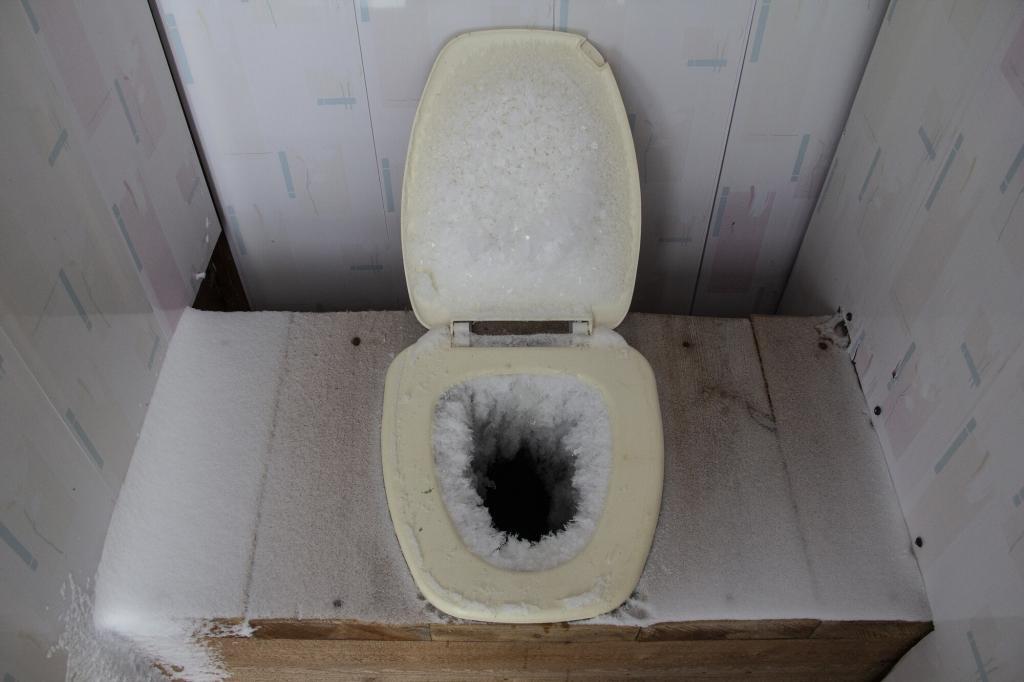
Similarly, hot, dry environments could cause rapid evaporation, reducing the effectiveness of certain waste disposal systems, like composting toilets, which could dry out.
Also, factors such as heavy rain or strong winds can affect both the stability of lighter bathroom setups and accessibility to outdoor facilities.
Always ensure your off grid bathroom can endure the specific weather conditions of your area for a smooth, efficient experience.
Accessories and Extras
While the core functionality is paramount, don’t overlook the benefits of useful add-ons.
Some off grid bathrooms come with additional features that can elevate your experience and add convenience. For instance, a toilet with a built-in sink or a shower attachment could enhance cleanliness and hygiene.
Privacy accessories, like a tent or a screen, might also be essential if you plan to set up your bathroom outdoors.
For those choosing portable options, look out for models that include carrying cases or bags for easier transport.
Also, consider extras like biodegradable toilet paper or waste disposal bags that are environmentally friendly.
Remember, the right accessories can turn a basic off grid bathroom into a more comfortable and efficient setup.
How Can I Build An Affordable Off Grid Bathroom
Start by considering what you really need. Will it just be you using the bathroom, or is there a whole family to think about? What level of comfort are you after?
Once you’ve got this figured out, you can choose a budget-friendly toilet system that’s right for you, from simple camping toilets to more sustainable composting options.
Next, think about water. You can make some great savings by using rainwater for washing and showering, or why not try a manually-filled portable shower for a quick and easy option?
When it comes to sinks and showers, a basic basin and a jug of water can work wonders, and a solar-heated shower bag in a privacy tent can give you that luxury feel without the hefty price tag.
And for waste disposal, composting or evaporation are both cost-effective options – just remember to check your local guidelines.
Last but not least, don’t be afraid to get creative with repurposed materials for your construction. You’ll save money and have a one-of-a-kind bathroom to show off!
Remember, building an off grid bathroom doesn’t have to be expensive — it’s all about making smart, affordable choices and having a bit of DIY fun along the way.
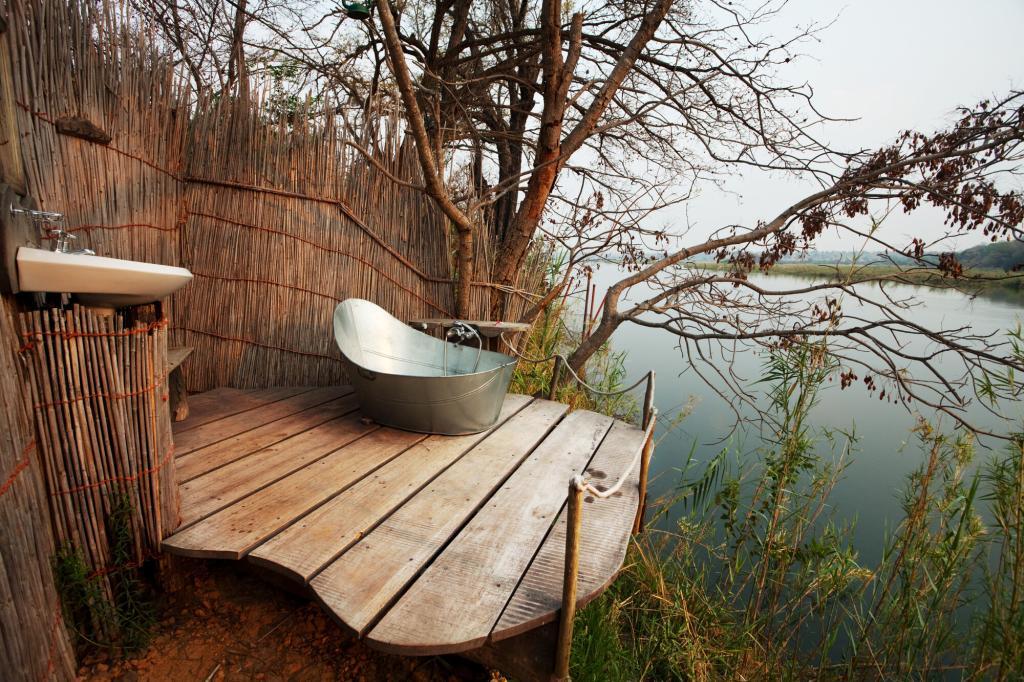
Frequently Asked Questions
How is a humanure toilet different from a composting toilet?
A humanure toilet and a composting toilet both compost human waste, but they function differently.
A composting toilet is a self-contained system that quickly composts waste within the unit through methods like aeration or heat.
Conversely, a humanure toilet is a simple setup, typically a bucket, where waste is manually moved to an external compost pile to decompose over a longer time.
So while both create compost, composting toilets offer faster, automated processing, whereas humanure toilets are simpler and more manual.
How can I ensure the comfort and ease of use of my off grid bathroom?
Ensuring comfort in your off grid bathroom starts with the right choice of facilities. Pick a toilet that aligns with your comfort levels, from composting toilets to simple bucket-style ones.
For bathing, solar showers or portable systems offer a warm, satisfying rinse.
Think about location too — it should be conveniently accessible, yet offer enough privacy. And don’t forget those little extras. For, instance, a comfy seat for your toilet or a small shelf for toiletries can transform your off grid bathroom from basic to cozy.
Can I have an outhouse with a shower and toilet?
Absolutely, you can have an outhouse with both a shower and toilet. It just requires careful planning and setup.
Your outhouse will need to be a bit larger to comfortably accommodate both. You’ll need a reliable water source for the shower, and consider how you’ll handle wastewater.
Also, think about heating options if you want warm showers, like a solar shower bag or a gas-powered water heater.
As for the toilet, composting or portable toilets are common off grid choices.
With these considerations, you can create a fully-functional off grid bathroom in your outhouse.
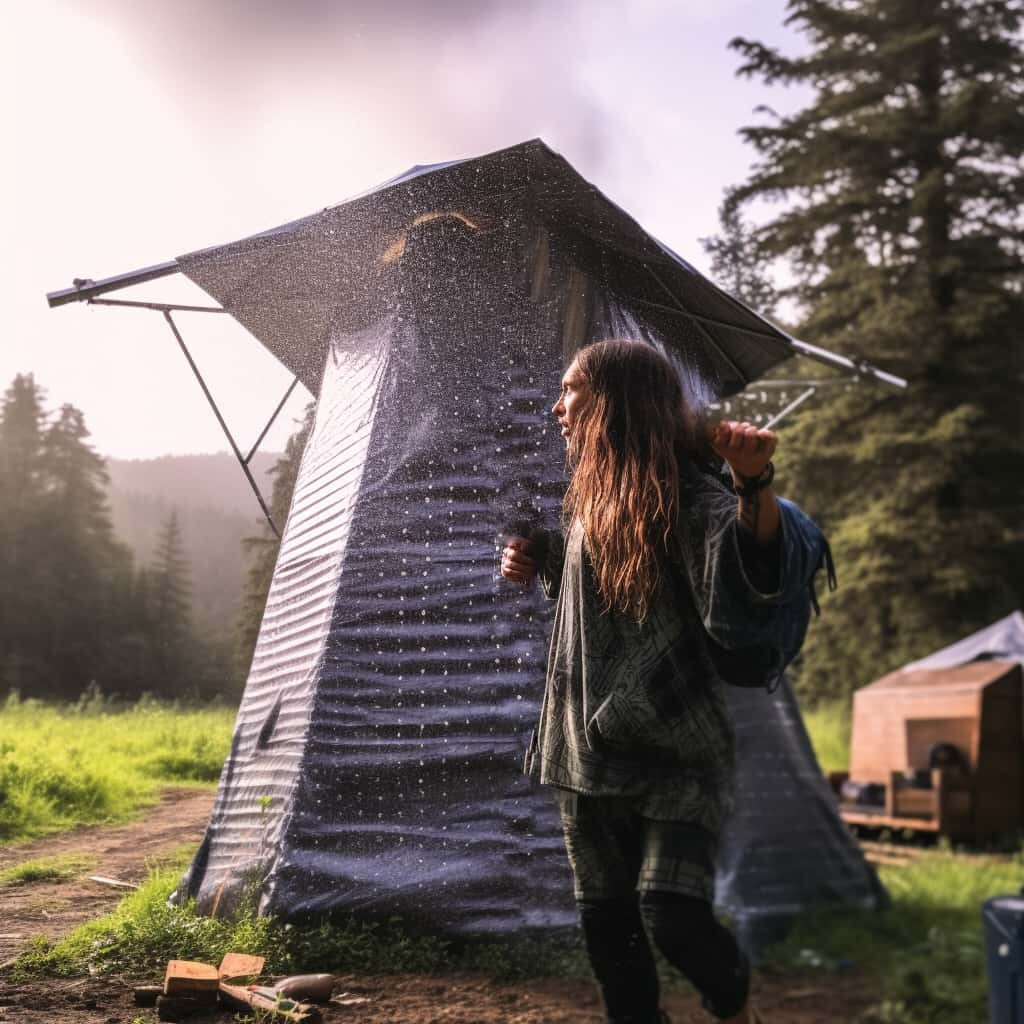
Off Grid Bathroom Ideas For Living When SHTF: Key Takeaways
Navigating through the world of off grid bathroom ideas, we’ve seen that comfort, adaptability, and a touch of creativity are key, especially when the grid goes down.
Remember, your best bet for an off grid bathroom setup is one that suits your survival strategies, caters to your personal needs, fits your budget, and is adaptable to your environment.
You might choose a simple yet effective bucket toilet or an ecologically conscious humanure system. Perhaps, the higher-end composting toilet aligns more with your prepping style.
Similarly, when it comes to keeping fresh and clean, a sun-soaked solar shower bag or a nifty portable shower system could be your new best friend.
In essence, preparing an off grid bathroom is about finding a balance between managing waste effectively and maintaining hygiene so that you can stay healthy and comfortable even in the harshest of situations.









